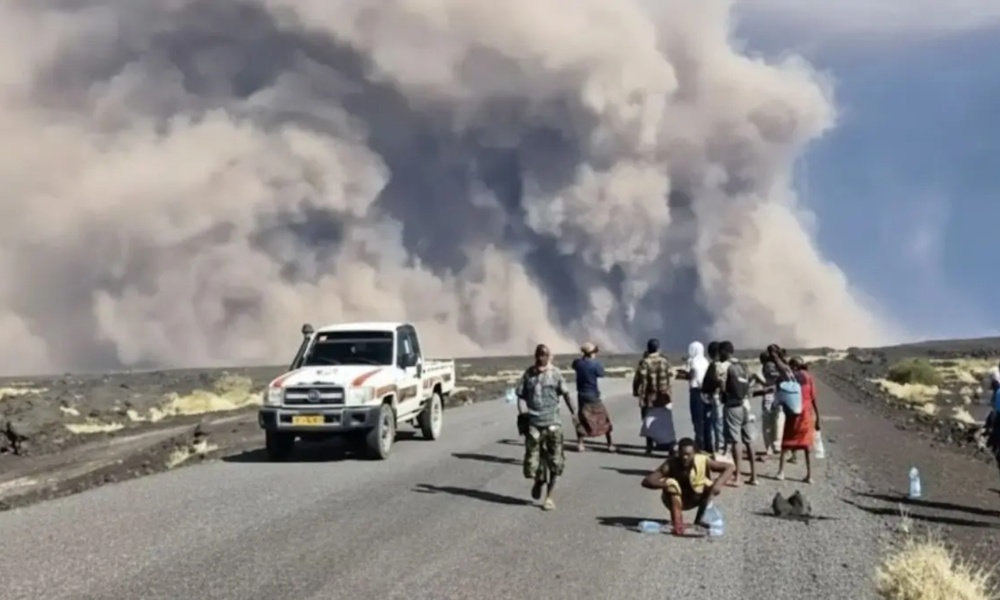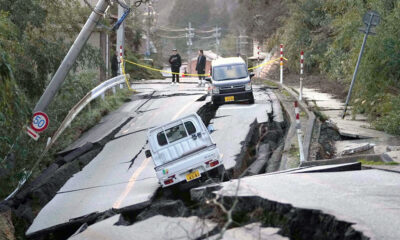Science & Technology
North Korea fires ballistic missiles, marking fourth in a week

North Korea fired two short-range ballistic missiles toward the sea off the east coast on Saturday, South Korea’s military said, marking Pyongyang’s fourth launch in a week as it ratchets up tension around the Korean peninsula, Reuters reported.
The launch comes after the navies of South Korea, the United States and Japan staged trilateral anti-submarine exercises on Friday for the first time in five years, and follows a visit by U.S. Vice President Kamala Harris to the region this week.
According to Reuters the two short-range missiles were launched from Sunan, north of the North Korean capital Pyongyang, South Korea’s Joint Chiefs of Staff said in a statement. It estimated the range at 350 km (220 miles) at 30 km (20 miles) altitude and speed of Mach 6.
Japan’s coast guard reported at least two suspected ballistic missile tests by Pyongyang. The missiles flew 400 km and 350 km, reaching an altitude of 50 km, said Toshiro Ino, state minister of defence.
Tokyo has lodged a protest against the North through diplomatic channels, Ino said, adding the missiles possibly flew an “irregular trajectory” designed to evade missile defence.
The U.S. Indo-Pacific Command said it is aware of the ballistic missile launches and has assessed they do not pose an immediate threat to U.S. personnel or territory or to its allies, read the report.
North Korea fired missiles before and after Harris’ visit to South Korea, extending a record pace in weapons testing this year as it increases the threat of a credible nuclear power that can strike the United States and its allies.
Pyongyang also conducted the first intercontinental ballistic missile test since 2017, Reuters reported.
Analysts see the increased pace of testing as an effort to build operational weapons, as well as to take advantage of a world distracted by the Ukraine conflict and other crises to “normalise” its tests.
“Despite North Korea’s internal weaknesses and international isolation, it is rapidly modernising weapons and taking advantage of a world divided by U.S.-China rivalry and Russia’s annexation of more Ukrainian territory,” said Leif-Eric Easley, a professor of international politics at Ewha University in Seoul.
“The Kim regime is also playing hardball with the Yoon administration while South Korean politics are hobbled by infighting,” referring to South Korean President Yoon Suk-yeol.
Japan’s Defence Ministry said in a report in July the North had been launching short-range missiles that fly low and irregular trajectories, characteristics observed since May 2019 that are likely designed for higher war-fighting effectiveness.
Marking South Korea’s 74th Armed Forces Day, President Yoon condemned what he called recent military provocations by the North and vowed to strengthen joint military drills with the United States.
“Going forward, the government will further strengthen the Korea-U.S. joint exercises, will respond strongly to North Korean provocations and threats by showing them the ‘Alliance in Action’,” Yoon said in a televised speech.
South Korea’s special representative for Korean Peninsula peace and security affairs, Kim Gunn, had telephone calls with his U.S. and Japanese counterparts, in which he said they jointly condemned Pyongyang’s missile tests. He said Saturday’s launch poses a “serious threat to the international community.”
The United Nations Security Council has imposed sanctions against the North for its ballistic missile and nuclear tests. Pyongyang rejects such moves as infringement of its sovereign right to self-defence and space exploration, Reuters reported.
The North has completed preparations for a nuclear test, a window which could open between China’s Communist Party congress in October and the U.S. mid-term elections in November, South Korean lawmakers said on Wednesday.
Science & Technology
Australia social media ban set to take effect, sparking a global crackdown
For the social media businesses, the implementation marks a new era of structural stagnation as user numbers flatline and time spent on platforms shrinks, studies show.

Australia is set to become the first country to implement a minimum age for social media use on Wednesday, with platforms like Instagram, TikTok and YouTube forced to block more than a million accounts, marking the beginning of an expected global wave of regulation.
From midnight, 10 of the biggest platforms will be required to block Australians aged under 16 or be fined up to A$49.5 million ($33 million), Reuters reported.
The law received harsh criticism from major technology companies and free speech advocates, but was praised by parents and child advocates.
The rollout closes out a year of speculation about whether a country can block children from using technology that is built into modern life. And it begins a live experiment that will be studied globally by lawmakers who want to intervene directly because they are frustrated by what they say is a tech industry that has been too slow to implement effective harm-minimisation efforts.
Governments from Denmark to Malaysia – and even some states in the U.S., where platforms are rolling back trust and safety features – say they plan similar steps, four years after a leak of internal Meta (META.O) documents showed the company knew its products contributed to body image problems and suicidal thoughts among teenagers while publicly denying the link existed.
“While Australia is the first to adopt such restrictions, it is unlikely to be the last,” said Tama Leaver, a professor of internet studies at Curtin University.
“Governments around the world are watching how the power of Big Tech was successfully taken on. The social media ban in Australia … is very much the canary in the coal mine.”
A spokesperson for the British government, which in July began forcing websites hosting pornographic content to block under-18 users, said it was “closely monitoring Australia’s approach to age restrictions.”
“When it comes to children’s safety, nothing is off the table,” they added.
Few will scrutinise the impact as closely as the Australians. The eSafety Commissioner, an Australian regulator tasked with enforcing the ban, hired Stanford University and 11 academics to analyse data on thousands of young Australians covered by the ban for at least two years.
Though the ban covers 10 platforms initially, including Alphabet’s (GOOGL.O), YouTube, Meta’s Instagram and TikTok, the government has said the list will change as new products appear and young users switch to alternatives.
Of the initial 10, all but Elon Musk’s X have said they will comply using age inference – guessing a person’s age from their online activity – or age estimation, which is usually based on a selfie. They might also check with uploaded identification documents or linked bank account details.
Musk has said the ban “seems like a backdoor way to control access to the internet by all Australians” and most platforms have complained that it violates people’s right to free speech.
For the social media businesses, the implementation marks a new era of structural stagnation as user numbers flatline and time spent on platforms shrinks, studies show.
Platforms say they don’t make much money showing advertisements to under-16s, but they add that the ban interrupts a pipeline of future users. Just before the ban took effect, 86% of Australians aged 8 to 15 used social media, the government said.
“The days of social media being seen as a platform for unbridled self-expression, I think, are coming to an end,” said Terry Flew, the co-director of University of Sydney’s Centre for AI, Trust and Governance.
Platforms responded to negative headlines and regulatory threats with measures like a minimum age of 13 and extra privacy features for teenagers, but “if that had been the structure of social media in the boom period, I don’t think we’d be having this debate,” he added.
Science & Technology
Ethiopian volcano erupts for first time in nearly 12,000 years
Ash from the eruption drifted across the region, spreading over Yemen, Oman, India, and parts of Pakistan.

The Hayli Gubbi volcano in Ethiopia’s Afar region has erupted for the first time in almost 12,000 years, sending massive ash plumes soaring up to 14 kilometres into the atmosphere, according to the Toulouse Volcanic Ash Advisory Centre.
The eruption began on Sunday and lasted several hours. Hayli Gubbi, located around 800 kilometres northeast of Addis Ababa near the Eritrean border, sits within the geologically active Rift Valley, where two major tectonic plates meet. The volcano rises roughly 500 metres above the surrounding landscape.
Ash from the eruption drifted across the region, spreading over Yemen, Oman, India, and parts of Pakistan. Satellite imagery and social-media videos captured a towering column of white smoke billowing into the sky.
The Smithsonian Institution’s Global Volcanism Program notes that Hayli Gubbi has no recorded eruptions during the Holocene, the period dating back about 12,000 years to the end of the last Ice Age.
Volcanologist Simon Carn of Michigan Technological University also confirmed on Bluesky that the volcano had “no record of Holocene eruptions.”
Science & Technology
Cloudflare outage easing after millions of internet users affected

A global outage at web-infrastructure firm Cloudflare began to ease on Tuesday afternoon after preventing people from accessing major internet platforms, including X and ChatGPT.
Cloudflare, whose network handles around a fifth of web traffic, said it started to investigate the internal service degradation around 6:40 a.m. ET. It has deployed a fix but some customers might still be impacted as it recovers service.
The incident marked the latest hit to major online services. An outage of Amazon’s cloud service last month caused global turmoil as thousands of popular websites and apps, including Snapchat, were inaccessible due to the disruption.
Cloudflare – whose shares were down about 5% in premarket trading – runs one of the world’s largest networks that helps websites and apps load faster and stay online by protecting them from traffic surges and cyberattacks.
The latest outage prevented users from accessing platforms such as Canva, X, and ChatGPT, prompting users to log outage reports with Downdetector.
Downdetector tracks outages by collating status reports from a number of sources. “We saw a spike in unusual traffic to one of Cloudflare’s services beginning at 11:20 UTC. That caused some traffic passing through Cloudflare’s network to experience errors,” the company said in an emailed statement.
“We are all hands on deck to make sure all traffic is served without errors.”
X and ChatGPT-creator OpenAI did not immediately respond to requests for comment. – REUTERS
-

 Sport4 days ago
Sport4 days agoILT20: Desert Vipers edge Gulf Giants in historic super over thriller
-

 Latest News2 days ago
Latest News2 days agoMuttaqi: Afghanistan’s progress requires both religious and modern education
-

 Regional4 days ago
Regional4 days agoSix Pakistani soldiers killed in TTP attack in Kurram District
-

 Business4 days ago
Business4 days agoTrade bodies warn almost 11,000 Afghan transit containers stuck at Karachi port
-

 World4 days ago
World4 days agoPowerful 7.6 earthquake hits northern Japan, tsunami warnings issued
-

 Latest News3 days ago
Latest News3 days agoTrump calls Afghanistan a ‘hellhole’ country as US expands immigration restrictions
-

 Sport5 days ago
Sport5 days agoSorkh Poshan Khafi defeats Sarsabz Yashlar 4-0 in Afghanistan Champions League
-

 Sport3 days ago
Sport3 days agoCommanding wins for Arman FC and Sarsabz Yashlar in Afghanistan Champions League
























